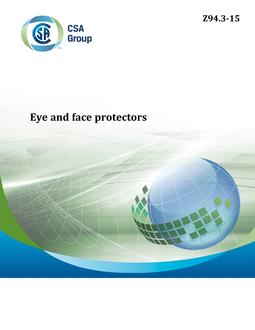Click here to purchase
Update #1 to this standard is available. To download any updates and/or register for email notification of future updates click here
Preface
This is the eighth edition of CSA Z94.3, Eye and face protectors. It supersedes the previous editions, published in 2007 and 2002 under the same title and in 1999, 1992, 1988, 1982, and 1969 under the title Industrial Eye and Face Protectors. Major changes to this edition include the following:
As introduced in the 2002 edition, the basic performance requirements apply to all protectors covered in this Standard, whereas the test procedures specified differ for prescription eyewear and nonprescription eyewear. As in previous editions, for non-prescription protectors, specified testing procedures are to be conducted using the whole assembled product (not individual components). In contrast, for Class 1 protectors having prescription lenses, performance criteria and test procedures are applied to lenses and frames separately. This Standard sets out requirements for the manufacture of these protectors (e.g., quality assurance). In addition, special allowance has been made in this edition for the role of ophthalmic professionals in adjusting and modifying spectacles to fit the individual wearer. When taken together, these requirements provide a basis for conformity assessment of protective spectacles with prescription lenses.
Scope
1.1 This Standard applies to eye and face protectors used in all occupational and educational operations or processes involving hazards to the eyes or face. Typical hazards include flying objects and particles, splashing liquids, molten metal, and ultraviolet, visible, and infrared radiation, but do not include X-rays, gamma rays, high-energy particulate radiation, radioactive materials, or masers. Note: The guidelines for protection outlined in Annex A should be followed when similar potentially hazardous activities are conducted in the home, at leisure, and in recreational environments. For certain sports activities, other Standards should be consulted (e.g., CSA Z262.2). 1.2 This Standard sets minimum performance requirements in the tests described herein but does not cover factors of design such as comfort, service life, or appearance. Note: The conformance of protectors with these requirements does not imply equality of performance, nor should it be interpreted to mean that protectors are capable of affording greater protection than is specified in this Standard. 1.3 In this Standard, “shall” is used to express a requirement, i.e., a provision that the user is obliged to satisfy in order to comply with the standard; “should” is used to express a recommendation or that which is advised but not required; and “may” is used to express an option or that which is permissible within the limits of the standard. Notes accompanying clauses do not include requirements or alternative requirements; the purpose of a note accompanying a clause is to separate from the text explanatory or informative material. Notes to tables and figures are considered part of the table or figure and may be written as requirements. Annexes are designated normative (mandatory) or informative (non-mandatory) to define their application.
Product Details
- Edition:
- 8th
- Published:
- 12/01/2015
- ISBN(s):
- 9781771399388
- Number of Pages:
- 92
- File Size:
- 1 file , 2.9 MB
- Redline File Size:
- 2 files , 9 MB
- Product Code(s):
- 2423717, 2424451, 2423717, 2423717
